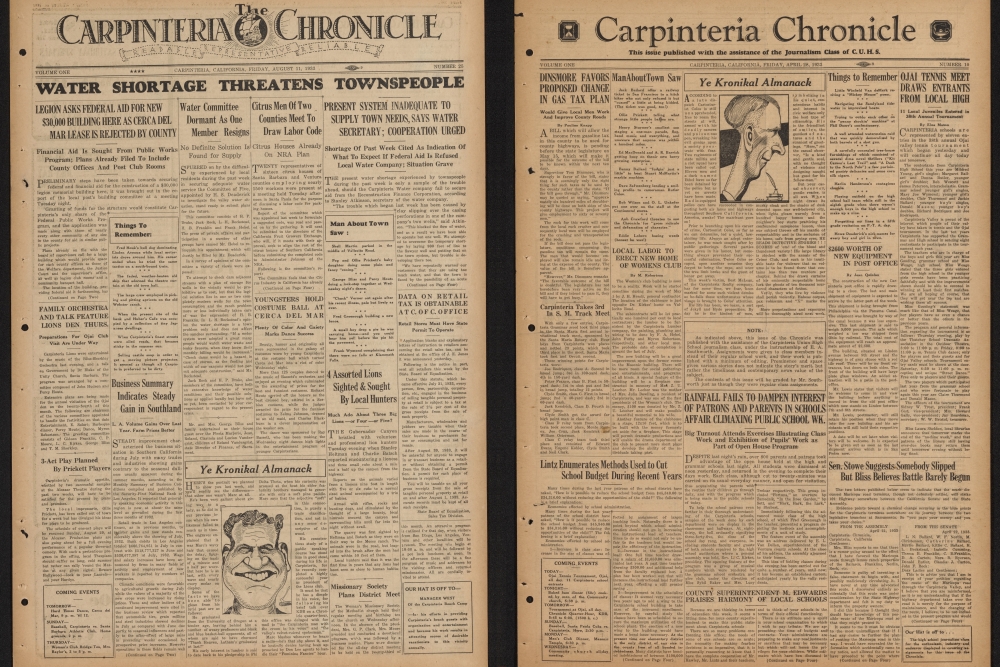
Coming to Light
Cleaning out a basement, attic or garage is tedious work. But the drudgery of the task is leavened by the hope that you might just find a piece of treasure — a long-forgotten object that evokes the distant past.
That’s what happened to Carpinteria native Joe Escareno, Jr. in April 2018. He and his sister were cleaning out the house of their aunt, Jessie Dominguez, when they came across a bound stack of old newspapers. Resisting an initial impulse to toss them in the trash, he called his childhood friend Jim Campos, a retired school administrator who has contributed to several volumes of Carpinteria history.
Campos was unenthusiastic at first, assuming they were copies of the well-known weekly newspaper the Carpinteria Herald. “But when he started describing them, I realized this was something different,” Campos recalled.
Indeed it was. Escareno had discovered copies of the long-forgotten one-time competitor to the Herald, the Carpinteria Chronicle. Until he held the copies in his hand, Campos had no idea it even existed.
The more he read, the more he realized that the 141 issues, published in 1933, 1934 and 1938, were a font of information regarding the community’s Depression-era attitudes and controversies. With the goal of both preserving them and providing the widest possible access to their content, he and Escareno decided to donate them to the UC Santa Barbara Library’s Department of Special Research Collections.
Digital copies of each issue are now available online through the library’s Alexandria Digital Research Library, at https://alexandria.ucsb.edu/collections/f3kh0rxf. Scholars and curious Carpinterians can look through them free of charge.
“They were very frail when they arrived,” said archival processing specialist Zachary Liebhaber. “That’s one reason we wanted them digitized — they’re too frail to be handled.”
The project “really was a team effort here at the library,” he added. “The newspapers were bound with string; we had to disbind them before they could be digitized. We worked with staff in Acquisitions and Resource Management with that, and then with staff in Content Management Services on cataloguing the material, and the creation of metadata for the Alexandria Digital Research Library.”
Thanks to their work, users can search the collection for specific topics. One that Campos found particularly compelling — and largely ignored by the rival Herald — is coverage of the creation of Aliso School in the 1930s.
“Aliso School was originally built in the 1890s on Walnut Street — right in the middle of town,” Campos said. “It needed to be torn down, but rather than rebuild it there, they looked for a place to put it on the Mexican side of town, so they could have de facto segregation without breaking the law.”
This is made crystal clear in the headline on the March 29, 1934 issue: “School Board Election Held Tomorrow PM. Segregation Looms as an Issue.” As the story explains, three candidates were vying for two seats on the school board, and two of them “have committed themselves to the principle of segregation in local schools, and have endorsed the Aliso bond issue.” The third, a man named John Young, “is opposed to segregation beyond the fourth grade.”
The results, as tabulated in the April 5, 1934 edition: Young got only 34 votes, compared to 227 and 219 for his opponents. The bond measure passed overwhelmingly.
The early issues of the Chronicle expressed progressive political views; one editorial approvingly quotes Will Rogers on how wealthy people like “John D.” (that would be Rockefeller) game the system. But within the first year, it was bought out by a different owner, Ann Waynflete, who took a conservative stance decidedly unfriendly to President Franklin Roosevelt’s policies.
One of her editorials reveals the cost of health care was as big an issue then as it is today. “The little fellow gets free medical attention,” it proclaims, not specifying where or how. “The man in the middle has to pay — $10 for an x-ray, $100 for an operation.”
The old Chronicle issues offer entertainment for today, too, in the form of advertising that appeared in its pages. A 1939 ad for Leibler’s Hi-Way Liquor Shop, “Carpinteria’s exclusive liquor shop for fine imported and domestic wines,” featured “fine wines in bulk,” including sherry and port for 93 cents per gallon, and burgundy, zinfandel and claret for 58 cents per gallon. The costs were apparently BYOJ — bring your own jug.
There are lots of smile-inducing headlines, such as “Legion Auxiliary Plans Poppy Sale,” “Ticket Money for Carnival Should be Turned in Now” and “Local Girl Wins Essay Contest.” But it also includes stories on crime, poverty (such as an announcement of a new WPA road-building project) and, as noted earlier, racial tensions.
“Some of the problems,” Liebhaber noted, “are no different from today.”



